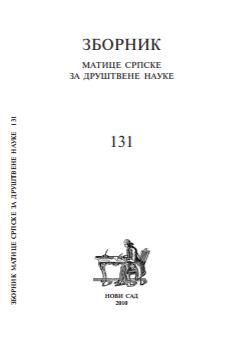СТАРЕЊЕ СТАНОВНИШТВА РЕПУБЛИКЕ СРБИЈЕ И БЕОГРАДА КРОЗ ПРИЗМУ ОДНОСА СТАРОСНЕ СТРУКТУРЕ СТАНОВНИШТВА И СТАРОСНЕ СТРУКТУРЕ ЧЛАНОВА ДОМАЋИНСТАВА
AGING OF THE POPULATION OF THE REPUBLIC OF SERBIA AND BELGRADE THROUGH THE PRISM OF THE RELATION OF THE AGE STRUCTURE OF THE POPULATION AND THE AGE SRUCTURE OF HOUSEHOLD MEMBERS
Author(s): Radmila VićentijevićSubject(s): Evaluation research, Family and social welfare, Demography and human biology
Published by: Матица српска
Keywords: population; average age; household; average household size; Serbia; Belgrade;
Summary/Abstract: The most important age structure represents an age structure of population. The results of census which was held on territory of the Republic of Serbia show that the Republic of Serbia is considered to be among the countries with the oldest population. In the last fifty year's time there was registered a constant decrease in number of young people, and constant increase in number of old people. During the period of the 80s, a number of young people from 0—14 years old was twice larger than the number of people older than 65, on the republic and the city of Belgrade's level, in the last census held in 2002 for the first time there was noticed a higher amount of people older than 65 related to population in an age from 0—14. An average old age of people in the Republic has grown from 35.8 to 40.3, and in Belgrade, which was always considered as a city of youth, it is noticed an increase in average old age from 34.9 to 40.4 years of age. Index of aging increased from 0.51 in the Republic of Serbia, 0.41 in Belgrade, to 1.01 or 1.07. In the Republic of Serbia and the city of Belgrade, for more than 50 years, the average size of household became smaller for more than one member, a number of single man households has increased for 5.5%, and participation of some old age groups in a structure of household members in a specific way shows a difficult demographic situation in Serbia and the city of Belgrade. Almost 83% of households in Central Serbia don't have even one pre-school child, and among households which have children at the age of 7, one child households form the majority. In the same period the number of households with members older than 65 has increased, so households like this in 2002 formed about 39%. Out of 435491 households in Serbia, every fifth household is named as OLD AGE HOUSEHOLD and SINGLE MAN HOUSEHOLD.
Journal: Зборник Матице српске за друштвене науке
- Issue Year: 2010
- Issue No: 131
- Page Range: 221-227
- Page Count: 7
- Language: Serbian

